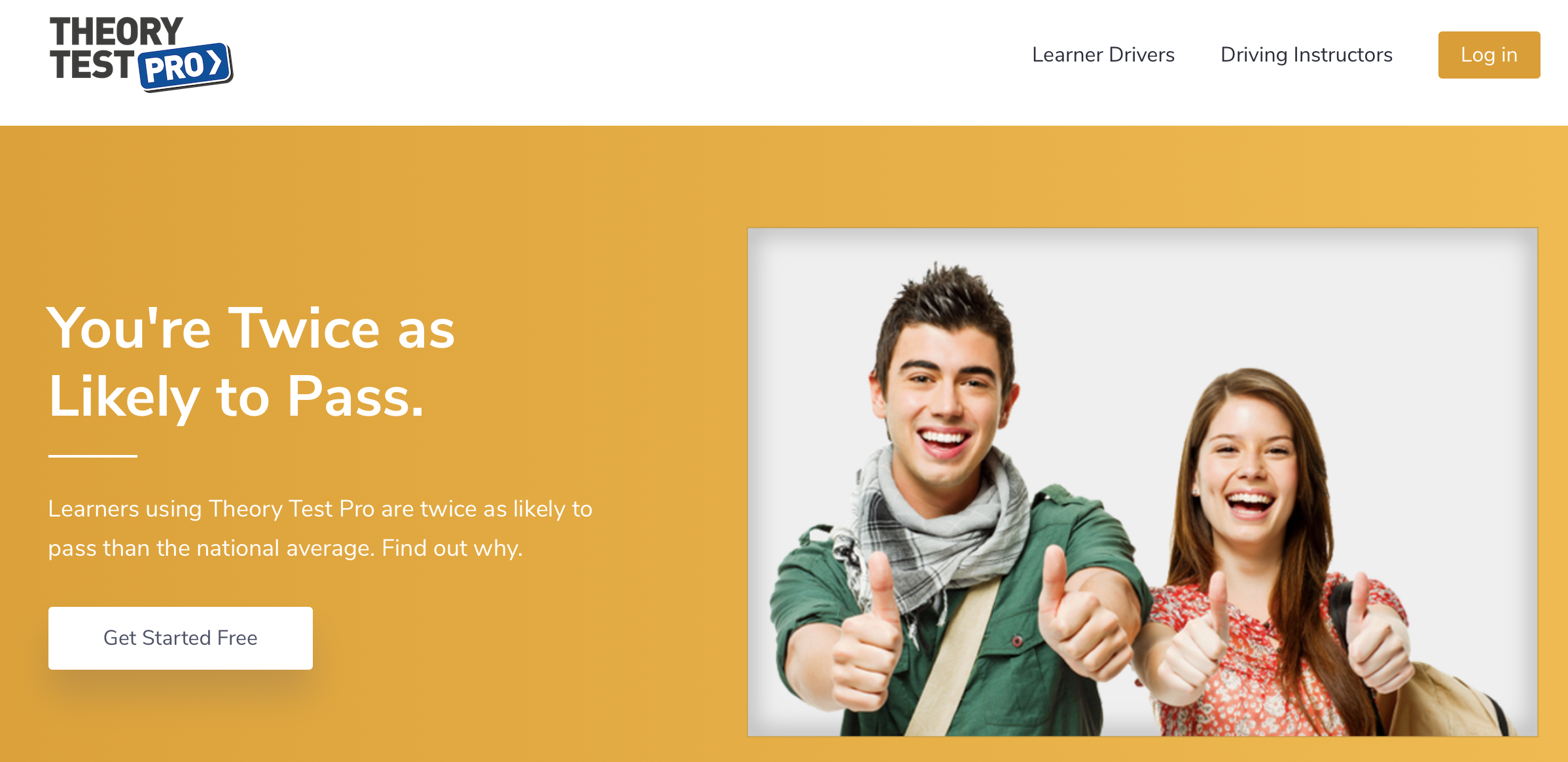Yes, we’re in lockdown but that doesn’t mean you can’t get ahead on your theory test practice. It’s why we’ve deep dived into Theory Test Pro’s database and uncovered the questions that users have failed the most over the past 12 months.
We reckon if you learn the answers to the following 27 brain-busters, it will put you in the best possible position to pass your test once test centres reopen. Good luck! P.S. You’ll find the answers listed at the end of the quiz.
1. What should you do before making a U-turn?
a. Give an arm signal as well as using your indicators.
b. Check road markings to see that U-turns are permitted.
c. Look over your shoulder for a final check.
d. Select a higher gear than normal.
2. Where may you overtake on a one-way street?
a. Only on the left-hand side.
b. Overtaking isn’t allowed.
c. Only on the right-hand side.
d. On either the right or the left.
3. You’re looking for somewhere to park at night. When may you park on the right-hand side of the road?
a. When you’re in a one-way street.
b. When you have your sidelights on.
c. When you’re more than 10 metres (32 feet) from a junction.
d. When you’re under a lamppost.
4. Your vehicle has broken down on a motorway. In which direction should you walk to find the nearest emergency telephone?
a. With the traffic flow.
b. Facing oncoming traffic.
c. In the direction shown on the marker posts.
d. In the direction of the nearest exit.
5. What should you do when you park at night on a road that has a 40 mph speed limit?
a. Park facing the traffic.
b. Leave parking lights switched on.
c. Leave dipped headlights switched on.
d. Park near a street light.
6. Why is travelling in neutral for long distances (known as coasting) bad driving technique?
a. It will cause the car to skid.
b. It will make the engine stall.
c. The engine will run faster.
d. There won’t be any engine braking.

7. You’re travelling in the left-hand lane of a three-lane motorway. How should you react to traffic joining from a slip road?
a. Increase your speed to ensure they join behind you.
b. Adjust your speed or change lane if you can do so safely.
c. Maintain a steady speed.
d. Switch on your hazard warning lights.
8. You’re travelling along a motorway. When are you allowed to overtake on the left?
a. When you can see well ahead that the hard shoulder is clear.
b. When the traffic in the right-hand lane is signalling right.
c. When you warn drivers behind by signalling left.
d. When in queues and traffic to your right is moving more slowly than you are.
9. Which vehicles are least likely to be affected by side wind?
a. Cyclists.
b. Motorcyclists.
c. High-sided vehicles.
d. Cars.
10. A casualty isn’t breathing normally and needs CPR. At what rate should you press down and release on the centre of their chest?
a. 10 times per minute.
b. 120 times per minute.
c. 60 times per minute.
d. 240 times per minute.
11. What’s the nearest you may park to a junction?
a. 10 metres (32 feet).
b. 12 metres (39 feet).
c. 15 metres (49 feet).
d. 20 metres (66 feet).

12. You’ve broken down on a two-way road. You have a warning triangle. At least how far from your vehicle should you place the warning triangle?
a. 5 metres (16 feet).
b. 25 metres (82 feet).
c. 45 metres (147 feet).
d. 100 metres (328 feet).
13. What colour are the reflective studs along the left-hand edge of the motorway?
a. Green.
b. Amber.
c. Red.
d. White.
14. How can you avoid wheelspin when you’re driving on an icy road?
a. Drive at a slow speed in the highest gear possible.
b. Use the parking brake if the wheels start to slip.
c. Brake gently and repeatedly.
d. Drive in a low gear at all times.
15. You’re turning right onto a dual carriageway. What should you do if the central reservation is too narrow to contain your vehicle?
a. Proceed to the central reservation and wait.
b. Wait until the road is clear in both directions.
c. Stop in the first lane so that other vehicles give way.
d. Emerge slightly to show your intentions.
16. What safety device must be fitted to a trailer braking system?
a. Stabiliser.
b. Jockey wheel.
c. Corner steadies.
d. Breakaway cable.
17. You’re driving a car fitted with automatic transmission. When would you use ‘kick down’?
a. To engage cruise control.
b. To accelerate quickly.
c. To brake progressively.
d. To improve fuel economy.

18. What’s the national speed limit on a single carriageway road for cars and motorcycles?
a. 30 mph.
b. 50 mph.
c. 60 mph.
d. 70 mph.
19. You’re following a slower-moving vehicle. What should you do if there’s a junction just ahead on the right?
a. Overtake after checking your mirrors and signalling.
b. Only consider overtaking when you’re past the junction.
c. Accelerate quickly to overtake before reaching the junction.
d. Slow down and prepare to overtake on the left.
20. How should you signal if you’re going straight ahead at a roundabout?
a. Signal right on the approach and then left to leave the roundabout.
b. Signal left after you leave the roundabout and enter the new road.
c. Signal right on the approach to the roundabout and keep the signal on.
d. Signal left just after you pass the exit before the one you’re going to take.
21. You’re parked on the road at night. When must you use parking lights?
a. When there are continuous white lines in the middle of the road.
b. When the speed limit exceeds 30 mph.
c. When you’re facing oncoming traffic.
d. When you’re near a bus stop.
22. You’re waiting to turn right out of a minor road. It’s clear to the left but a lorry is coming from the right. Why should you wait, even if you have enough time to turn?
a. Anything overtaking the lorry will be hidden from view.
b. The lorry could suddenly speed up.
c. The lorry might be slowing down.
d. The load on the lorry might be unstable.
23. You’re turning right at a crossroads. An oncoming driver is also turning right. How should you normally deal with this?
a. Keep the other vehicle to your right and turn behind it (offside to offside).
b. Keep the other vehicle to your left and turn in front of it (nearside to nearside).
c. Carry on and turn at the next junction instead.
d. Hold back and wait for the other driver to turn first.

24. You’re on a country road that has no pavement. What should you anticipate finding on your side of the road?
a. Motorcycles.
b. Bicycles.
c. Pedestrians.
d. Horse riders.
25. Which colour follows the green signal at a puffin crossing?
a. Steady red.
b. Flashing amber.
c. Steady amber.
d. Flashing green.
26. What colour are the reflective studs between the hard shoulder and the left-hand lane of a motorway?
a. Green.
b. Red.
c. White.
d. Amber.
27. You’re driving at night with your headlights on main beam. A vehicle is overtaking you. When should you dip your headlights?
a. Some time after the vehicle has passed you.
b. Before the vehicle starts to pass you.
c. Only if the other driver dips their headlights.
d. As soon as the vehicle passes you.
Answers to the Top 27 Toughest Theory Test Questions

1. What should you do before making a U-turn?
c. Look over your shoulder for a final check.
2. Where may you overtake on a one-way street?
d. On either the right or the left.
3. You’re looking for somewhere to park at night. When may you park on the right-hand side of the road?
a. When you’re in a one-way street.
4. Your vehicle has broken down on a motorway. In which direction should you walk to find the nearest emergency telephone?
c. In the direction shown on the marker posts.
5. What should you do when you park at night on a road that has a 40 mph speed limit?
b. Leave parking lights switched on.
6. Why is travelling in neutral for long distances (known as coasting) bad driving technique?
d. There won’t be any engine braking.
7. You’re travelling in the left-hand lane of a three-lane motorway. How should you react to traffic joining from a slip road?
b. Adjust your speed or change lane if you can do so safely.
8. You’re travelling along a motorway. When are you allowed to overtake on the left?
d. When in queues and traffic to your right is moving more slowly than you are.
9. Which vehicles are least likely to be affected by side wind?
d. Cars.
10. A casualty isn’t breathing normally and needs CPR. At what rate should you press down and release on the centre of their chest?
b. 120 times per minute.
11. What’s the nearest you may park to a junction?
a. 10 metres (32 feet).
12. You’ve broken down on a two-way road. You have a warning triangle. At least how far from your vehicle should you place the warning triangle?
c. 45 metres (147 feet).
13. What colour are the reflective studs along the left-hand edge of the motorway?
c. Red.
14. How can you avoid wheelspin when you’re driving on an icy road?
a. Drive at a slow speed in the highest gear possible.
15. You’re turning right onto a dual carriageway. What should you do if the central reservation is too narrow to contain your vehicle?
b. Wait until the road is clear in both directions.
16. What safety device must be fitted to a trailer braking system?
d. Breakaway cable.
17. You’re driving a car fitted with automatic transmission. When would you use ‘kick down’?
b. To accelerate quickly.
18. What’s the national speed limit on a single carriageway road for cars and motorcycles?
c. 60 mph.
19. You’re following a slower-moving vehicle. What should you do if there’s a junction just ahead on the right?
b. Only consider overtaking when you’re past the junction.
20. How should you signal if you’re going straight ahead at a roundabout?
d. Signal left just after you pass the exit before the one you’re going to take.
21. You’re parked on the road at night. When must you use parking lights?
b. When the speed limit exceeds 30 mph.
22. You’re waiting to turn right out of a minor road. It’s clear to the left but a lorry is coming from the right. Why should you wait, even if you have enough time to turn?
a. Anything overtaking the lorry will be hidden from view.
23. You’re turning right at a crossroads. An oncoming driver is also turning right. How should you normally deal with this?
a. Keep the other vehicle to your right and turn behind it (offside to offside).
24. You’re on a country road that has no pavement. What should you anticipate finding on your side of the road?
c. Pedestrians.
25. Which colour follows the green signal at a puffin crossing?
c. Steady amber.
26. What colour are the reflective studs between the hard shoulder and the left-hand lane of a motorway?
b. Red.
27. You’re driving at night with your headlights on main beam. A vehicle is overtaking you. When should you dip your headlights?
d. As soon as the vehicle passes you.
Coming up short? We’re here to help!

Double your chances of theory test success with Theory Test Pro – sign up for free here.
